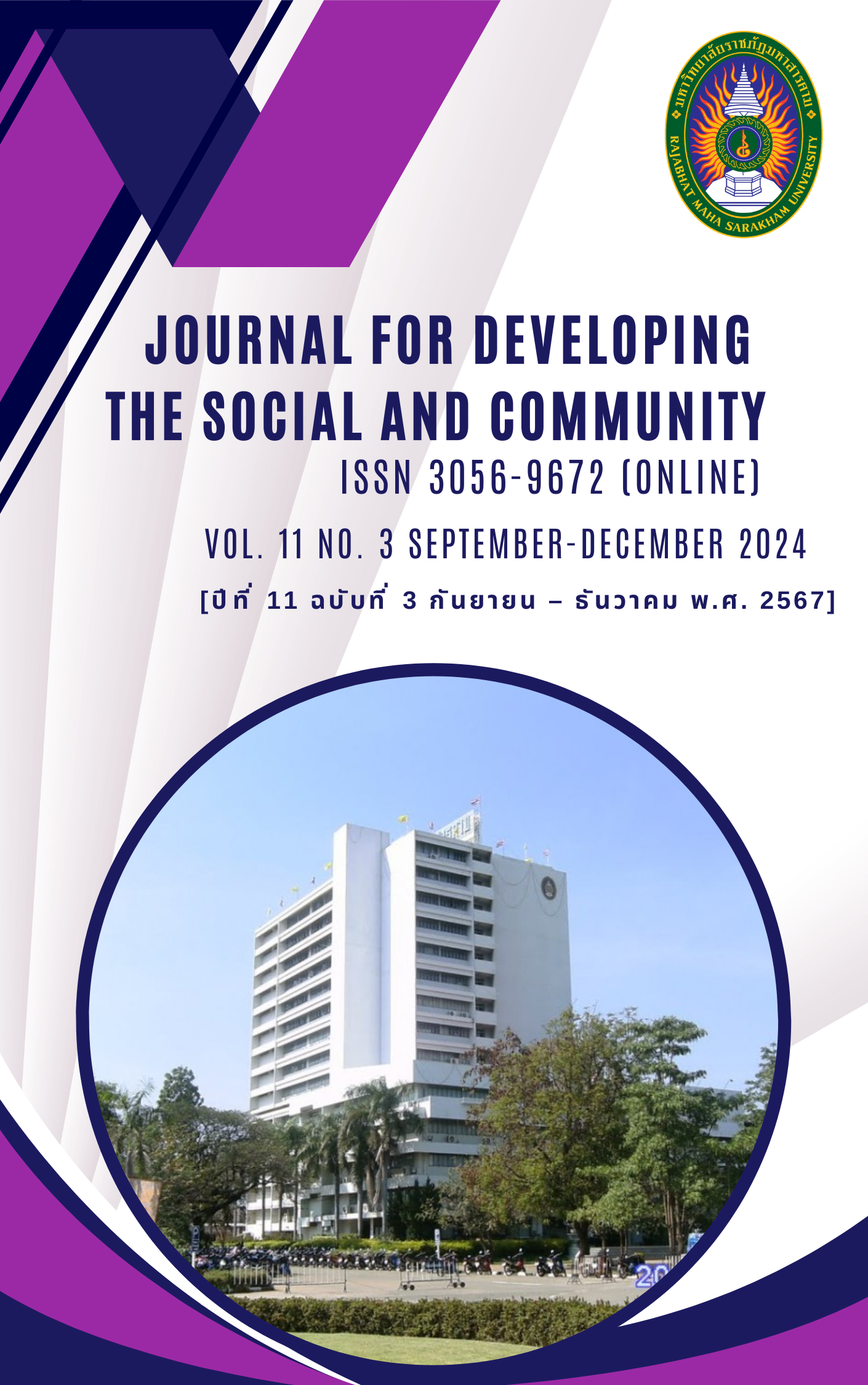การพัฒนามโนทัศน์ทางวิทยาศาสตร์ โดยการจัดการเรียนรู้ด้วยวิธีการสร้างแบบจำลอง-สังเกต-สะท้อนความคิด-อธิบาย ร่วมกับการใช้เทคโนโลยีเสมือนจริง
คำสำคัญ:
มโนทัศน์ทางวิทยาศาสตร์, เทคโนโลยีเสมือนจริง, การจัดการเรียนรู้การสร้างแบบจําลอง-สังเกต-สะท้อนความคิด-อธิบายบทคัดย่อ
การวิจัยเชิงปฏิบัติการครั้งนี้มีจุดมุ่งหมายเพื่อ 1) เพื่อพัฒนามโนทัศน์ทางวิทยาศาสตร์ ด้วยวิธีการสร้างแบบจำลอง-สังเกต-สะท้อนความคิด-อธิบาย ร่วมกับการใช้เทคโนโลยีเสมือนจริง ให้อยู่ในระดับมโนทัศน์ที่ถูกต้องแต่ไม่สมบูรณ์ขึ้นไป 2) เพื่อศึกษามโนทัศน์ทางวิทยาศาสตร์ของนักเรียนหลังการจัดการเรียนรู้ด้วยวิธีการสร้างแบบจำลอง-สังเกต-สะท้อนความคิด-อธิบาย ร่วมกับการใช้เทคโนโลยีเสมือนจริง กลุ่มเป้าหมายเป็นนักเรียนชั้นมัธยมศึกษาปีที่ 4 จำนวน 16 คน เลือกแบบเจาะจงจากนักเรียนที่มีปัญหามโนทัศน์ทางวิทยาศาสตร์ของโรงเรียนกาฬสินธุ์พิทยาสรรพ์ โดยแบ่งเป็น 3 วงรอบ เครื่องมือที่ใช้ในการวิจัยมี 4 ชนิด ได้แก่ (1) แผนการเรียนรู้ (2) แบบวัดมโนทัศน์ทางวิทยาศาสตร์ (3) แบบสัมภาษณ์นักเรียน (4) แบบสังเกตพฤติกรรม ผลการศึกษา พบว่า นักเรียนกลุ่มเป้าหมายผ่านเกณฑ์มโนทัศน์ทางวิทยาศาสตร์ที่ถูกต้องแต่ไม่สมบูรณ์ขึ้นไปทั้งสิ้น 15 คน คิดเป็นร้อยละ 93.75 ของกลุ่มเป้าหมายทั้งหมด สามารถแบ่งเป็นวงรอบได้ดังนี้
วงรอบปฎิบัติการที่ 1 นักเรียนผ่านเกณฑ์มโนทัศน์ทางวิทยาศาสตร์ที่ถูกต้องแต่ไม่สมบูรณ์ขึ้นไปทั้งสิ้น 9 คน คิดเป็นร้อยละ 56.25 ของกลุ่มเป้าหมายทั้งหมด และนักเรียนส่วนใหญ่มีระดับมโนทัศน์ทางวิทยาศาสตร์ถูกต้องแต่ไม่สมบูรณ์ (PU)
วงรอบปฏิบัติการที่ 2 นักเรียนผ่านเกณฑ์มโนทัศน์ทางวิทยาศาสตร์ที่ถูกต้องแต่ไม่สมบูรณ์ขึ้นไปทั้งสิ้น 14 คน คิดเป็นร้อยละ 87.50 ของกลุ่มเป้าหมายทั้งหมด และนักเรียนส่วนใหญ่มีระดับมโนทัศน์ทางวิทยาศาสตร์ที่สมบูรณ์ (SU)
วงรอบปฏิบัติการที่ 3 นักเรียนผ่านเกณฑ์มโนทัศน์ทางวิทยาศาสตร์ที่ถูกต้องแต่ไม่สมบูรณ์ขึ้นไปทั้งสิ้น 15 คน คิดเป็นร้อยละ 93.75 ของกลุ่มเป้าหมายทั้งหมด และนักเรียนส่วนใหญ่มีระดับมโนทัศน์ทางวิทยาศาสตร์ถูกต้องแต่ไม่สมบูรณ์ (PU)
References
Boonrod, J. (2014). EFFECT OF SCIENCE INSTRUCTION USING MODEL ON SCIENCE LEARNINGACHIEVEMENT AND SCIENTIFIC EXPLANATION ABILITY OFLOER SECONDARY SCHOOL STUDENTS. Master’s thesis: Chulalongkorn University.
Caeillo, C., Lee, C., & Reicky, D. (2005). Enhancing science teaching by doing : A framework to guide chemistry student's thinking in the laboratory. National Science Teachers Association, 72(7), 60-64.
Elliott, S., Kratochwill, T., Littlefield Cook, J., & Travers, J. (2000). Effective teaching, effective learning (3rded). Boston: McGraw-Hill College.
Gilbert, J. (2005). Visualization in science education. Netherlands: springer.
Gilbert, J., Boulter, C., & Elmer, R. (2000). Developing Models in Science Education. Kluwer Academic Publishers: Printed in the Netherlands.
Haidar. (1997). Prospective Chemistry Teachers’ Conceptions of the Conservation of Matter and Related Concepts. journal of research in science teaching, 171-197.
Johnstone, A. H. (1993). Starter projects for sixth year studies. Glasgow: Centre for Science Education.
Kantho, T. (2020). Applying three levels of thinking with animation to develop secondary school students' scientific conceptual understanding of the separation of substance Master’s thesis: Chiang Mai University.
Ketsing, J. (2019). Science classroom action research: A learning pathway for improving you. Master’s thesis: Kasetsart University.
Khemthong, P., Khaomek, P., & Sukprasertchai, T. (2017). The Development of Matthayomsuksa 4th ’s Scientific Concepts on Covalent Bond Using Model Observe-Reflect-Explain (MORE) with Augmented Reality Technologies (AR). Nation Academic conference. Khon Kaen: University.
Mattox, A., Reisner, B., & Rickey, D. (2006). What happens when chemical compounds are added to water? An introduction to the Model-Observe-Reflect-Explain (MORE) Thinking. Journal of Chemical Education, 84(4), 622-624.
Meesuwan, W. (2011). Learning by creating a virtual world combining the real world. Journal of Naresuan University. 13(2), 119-127.
Moutinho, s., Moura, R., & Vasconcelos, C. (2017). Contributions if model-based learning to the restructuring of graduation students' mental on natural hazards. Journal of Mathematics Science and Technology Education, 13(7), 3043-3068.
Office of the Basic Education Commission. (2008). Basic Education Core Curriculum 2008. Bangkok: Agricultural Cooperatives Association of Thailand Printing Company Limited.
Office of the National Education Commission Office of the Prime Minister. (2002). National Education Act 1999 and amendments (No. 2) 2002. Bangkok: Phrik Wan Graphic Company Limited.
Promrit. S. (2019). Understanding scientific concepts. Titration matters For Mathayom 5 students, learning is organized by modeling observation-reflection-explanation. together with explaining three levels of chemical phenomena. Journal of Humanities and Social Sciences, 6(2), 83-96.
Tien, T., Ricky, D., & Stacy, M. (2017). The MORE Thinking Frame: Guiding Students' Thinking in the Laboratory. Journal of College Science Teaching, 318-324.
Downloads
เผยแพร่แล้ว
How to Cite
ฉบับ
บท
License
Copyright (c) 2024 Journal for Developing the Social and Community

This work is licensed under a Creative Commons Attribution-NonCommercial-NoDerivatives 4.0 International License.
บทความที่ได้รับการตีพิมพ์เป็นลิขสิทธิ์เป็นของผู้ประพันธ์บทความ






